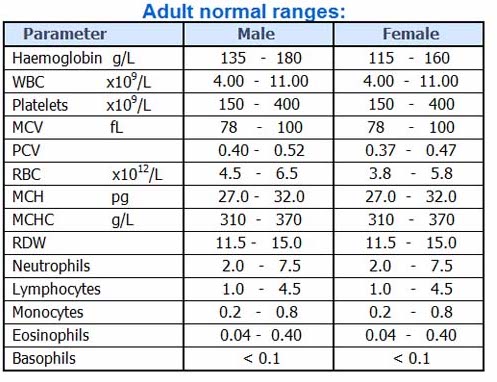

The normal reference range is typically provided and printed with the results of the complete blood count for accurate interpretation. The normal values may differ slightly based on the reference range and the machine used in the laboratory and, therefore, the results may be slightly different from one laboratory to the next. The complete blood count values are usually reported based on the number of cells in a specific volume of blood. What Are Values for Components of Complete Blood Count?
#MPV BLOOD TEST NORMAL RANGE MANUAL#
This is called the manual differential analysis. This method is still widely used when results of a complete blood count need further review to confirm certain abnormal values, or a doctor wants to see how the blood cells look (for example, if any abnormal features are present which would not be reported by an automated complete blood count). This is usually done by a trained laboratory technologist or a doctor. The conventional method to analyze these data is to obtain a small sample of the collected blood and place it on a glass slide for visual review under a microscope. This is called an automated cell count and differential. A small sample of the blood drawn from a person is fed into the machine and within a few minutes, the values of the components of the complete blood count are displayed and printed for review. The complete blood count analysis is routinely and reliably done by automated machines in most laboratories. The blood sample drawn for a complete blood count is analyzed in a medical laboratory. SLIDESHOW Health Screening Tests Every Woman Needs See Slideshow The different types of WBCs that have specific functions that are routinely reported in a complete blood count are neutrophils, lymphocytes, basophils, eosinophils, and monocytes. The white blood cell (WBC) differential refers to the number of the different types of white blood cells seen in the blood. The other components represent additional information about these cells including their size, color, function, and maturity. The main components are the blood cells such as white blood cells, red blood cells, and platelets. Mean corpuscular hemoglobin concentration (MCHC).Red blood cell count (RBC or erythrocyte count).White blood cell count (WBC or Leukocyte count).The complete blood count generally includes the following components: The complete blood count interpretation is done by doctors who review the results of the testing. The complete blood count measures many important values pertaining to the blood cells. A sample that is not delivered in a timely manner may yield inaccurate results. Prompt delivery of the blood sample to the laboratory for analysis is important. This sample is then taken to the laboratory for analysis, and the complete blood count results may be available within hours after collection. The blood is then pulled from the vein via the needle by gently pulling the plunger on the syringe or by a connection of the needle to a special vacuum vial that collects the blood.
#MPV BLOOD TEST NORMAL RANGE SKIN#
The skin overlying the vein is cleaned using an alcohol pad, and then a needle is inserted through the area of cleansed skin into the vein below where the tourniquet is applied. The tourniquet is only applied for a brief period of time (a few minutes at the most) and it is removed as soon as the blood is drawn. This technique will make the vein more visible and plump by limiting the blood from the vein going back toward the heart. Most commonly, the sample is obtained from a vein that is visible from the skin, such as a vein on the back of the hand or the inner angle of the elbow (antecubital fossa).Ī tourniquet is usually applied to the area proximal to the vein (closer to the center of the body than the vein itself). The complete blood count test is performed by drawing a few milliliters (one to two teaspoons) of blood from a vein.

The complete blood count may be done in many different healthcare settings including doctors' offices, clinics, urgent care facilities, emergency rooms, hospitals, and outpatient medical laboratories.


 0 kommentar(er)
0 kommentar(er)
